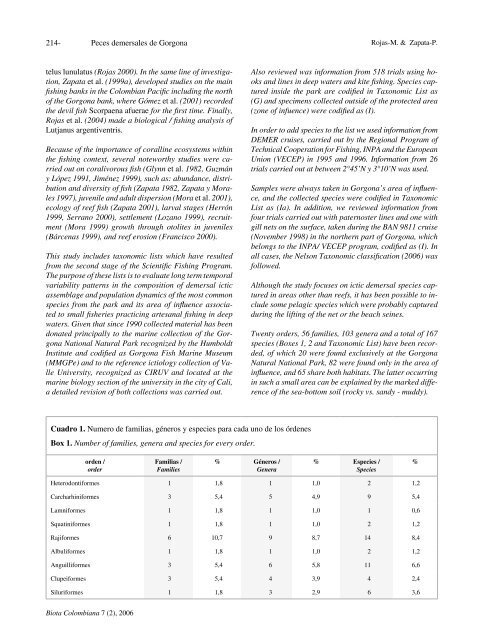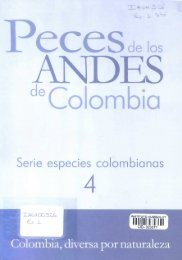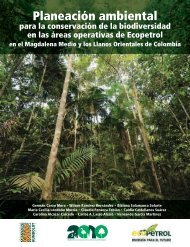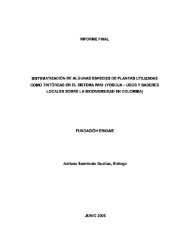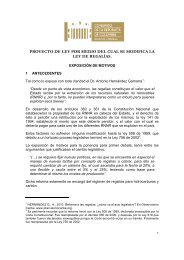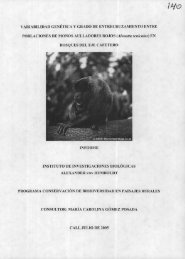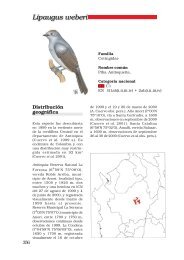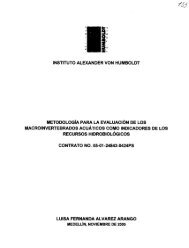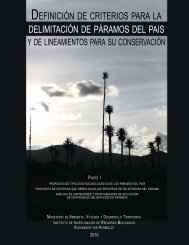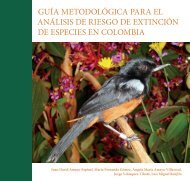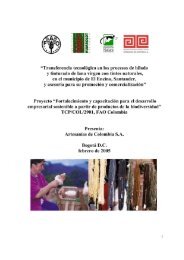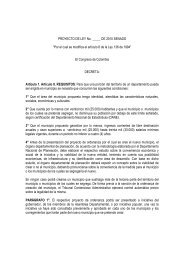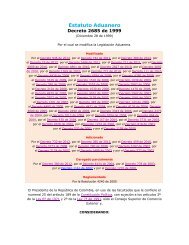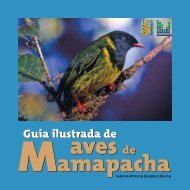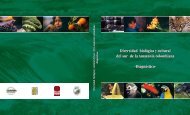biota colombiana - Instituto de Investigación de Recursos Biológicos ...
biota colombiana - Instituto de Investigación de Recursos Biológicos ...
biota colombiana - Instituto de Investigación de Recursos Biológicos ...
You also want an ePaper? Increase the reach of your titles
YUMPU automatically turns print PDFs into web optimized ePapers that Google loves.
214- Peces <strong>de</strong>mersales <strong>de</strong> Gorgona Rojas-M. & Zapata-P.<br />
telus lunulatus (Rojas 2000). In the same line of investigation,<br />
Zapata et al. (1999a), <strong>de</strong>veloped studies on the main<br />
fishing banks in the Colombian Pacific including the north<br />
of the Gorgona bank, where Gómez et al. (2001) recor<strong>de</strong>d<br />
the <strong>de</strong>vil fish Scorpaena afuerae for the first time. Finally,<br />
Rojas et al. (2004) ma<strong>de</strong> a biological / fishing analysis of<br />
Lutjanus argentiventris.<br />
Because of the importance of coralline ecosystems within<br />
the fishing context, several noteworthy studies were carried<br />
out on coralivorous fish (Glynn et al. 1982, Guzmán<br />
y López 1991, Jiménez 1999), such as: abundance, distribution<br />
and diversity of fish (Zapata 1982, Zapata y Morales<br />
1997), juvenile and adult dispersion (Mora et al. 2001),<br />
ecology of reef fish (Zapata 2001), larval stages (Herrón<br />
1999, Serrano 2000), settlement (Lozano 1999), recruitment<br />
(Mora 1999) growth through otolites in juveniles<br />
(Bárcenas 1999), and reef erosion (Francisco 2000).<br />
This study inclu<strong>de</strong>s taxonomic lists which have resulted<br />
from the second stage of the Scientific Fishing Program.<br />
The purpose of these lists is to evaluate long term temporal<br />
variability patterns in the composition of <strong>de</strong>mersal ictic<br />
assemblage and population dynamics of the most common<br />
species from the park and its area of influence associated<br />
to small fisheries practicing artesanal fishing in <strong>de</strong>ep<br />
waters. Given that since 1990 collected material has been<br />
donated principally to the marine collection of the Gorgona<br />
National Natural Park recognized by the Humboldt<br />
Institute and codified as Gorgona Fish Marine Museum<br />
(MMGPe) and to the reference ictiology collection of Valle<br />
University, recognized as CIRUV and located at the<br />
marine biology section of the university in the city of Cali,<br />
a <strong>de</strong>tailed revision of both collections was carried out.<br />
Cuadro 1. Numero <strong>de</strong> familias, géneros y especies para cada uno <strong>de</strong> los ór<strong>de</strong>nes<br />
Box 1. Number of families, genera and species for every or<strong>de</strong>r.<br />
or<strong>de</strong>n /<br />
or<strong>de</strong>r<br />
Biota Colombiana 7 (2), 2006<br />
Familias /<br />
Families<br />
% Géneros /<br />
Genera<br />
Also reviewed was information from 518 trials using hooks<br />
and lines in <strong>de</strong>ep waters and kite fishing. Species captured<br />
insi<strong>de</strong> the park are codified in Taxonomic List as<br />
(G) and specimens collected outsi<strong>de</strong> of the protected area<br />
(zone of infuence) were codified as (I).<br />
In or<strong>de</strong>r to add species to the list we used information from<br />
DEMER cruises, carried out by the Regional Program of<br />
Technical Cooperation for Fishing, INPA and the European<br />
Union (VECEP) in 1995 and 1996. Information from 26<br />
trials carried out at between 2°45’N y 3°10’N was used.<br />
Samples were always taken in Gorgona’s area of influence,<br />
and the collected species were codified in Taxonomic<br />
List as (Ia). In addition, we reviewed information from<br />
four trials carried out with paternoster lines and one with<br />
gill nets on the surface, taken during the BAN 9811 cruise<br />
(November 1998) in the northern part of Gorgona, which<br />
belongs to the INPA/ VECEP program, codified as (I). In<br />
all cases, the Nelson Taxonomic classification (2006) was<br />
followed.<br />
Although the study focuses on ictic <strong>de</strong>mersal species captured<br />
in areas other than reefs, it has been possible to inclu<strong>de</strong><br />
some pelagic species which were probably captured<br />
during the lifting of the net or the beach seines.<br />
Twenty or<strong>de</strong>rs, 56 families, 103 genera and a total of 167<br />
species (Boxes 1, 2 and Taxonomic List) have been recor<strong>de</strong>d,<br />
of which 20 were found exclusively at the Gorgona<br />
Natural National Park, 82 were found only in the area of<br />
influence, and 65 share both habitats. The latter occurring<br />
in such a small area can be explained by the marked difference<br />
of the sea-bottom soil (rocky vs. sandy - muddy).<br />
% Especies /<br />
Species<br />
Heterodontiformes 1 1,8 1 1,0 2 1,2<br />
Carcharhiniformes 3 5,4 5 4,9 9 5,4<br />
Lamniformes 1 1,8 1 1,0 1 0,6<br />
Squatiniformes 1 1,8 1 1,0 2 1,2<br />
Rajiformes 6 10,7 9 8,7 14 8,4<br />
Albuliformes 1 1,8 1 1,0 2 1,2<br />
Anguilliformes 3 5,4 6 5,8 11 6,6<br />
Clupeiformes 3 5,4 4 3,9 4 2,4<br />
Siluriformes 1 1,8 3 2,9 6 3,6<br />
%


